Sometimes you've got to wonder, haven't you. It's been eight years since High Speed 2 went under consultation/planning, and yet not a single sleeper has been laid. With a budget of £56 billion - and the taxpayer footing the bill - it's a far cry from the public enterprise of ye olden days, where a bunch of lads saw the need for a railway, and just went ahead and built one.
Railway Empire is a game set in the days before waiting boards, before on board coffee, and before even electricity, as the pioneers in the US of A looked to put a little known British invention to work (in the form of the steam engine) to solve one very big problem. Needing a way to cross the vast country that wouldn't take them six months to cover a few miles, ye olde steam trains provided an elegant way to ship goods, passengers, and even letters from A to B. But it wasn't without its headaches, as Railway Empire shows.
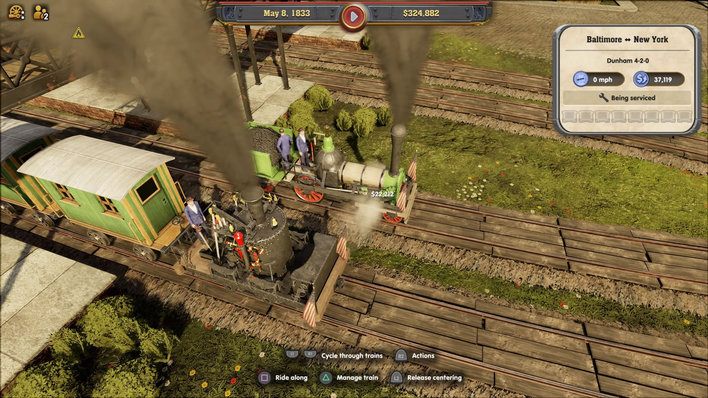
Let's have a race, have a race, have a race, let's see who is the quickest
A tycoon style game in the vein of the classic games of yore, Railway Empire at least starts out with a fairly simple premise. Played from a top down view, you've got a load of towns, a fat wodge in the bank, and a few menus to peruse that let you build railway stations, lay track, and purchase trains. By having a gander at what each city needs, it's up to you to build the right stations in the right places to take the right goods to the right cities - but that's an awful lot to get right...
In fact, even laying the tracks to begin requires a bit more thinking than you might imagine. While flat terrain is easy enough to navigate, any inclines or declines are much trickier for trains to handle. The game will automatically do its best to minimise any ups and downs - but at the cost of having to lay expensive foundations, dig costly trenches, or pour every last penny you own into boring a huge tunnel. Luckily, the game has a really handy system that lets you tweak your layouts by simply clicking on any part of the track, and dragging it to where you'd rather it went from - something which can save you literal millions in game if you think long and hard about where you build things....
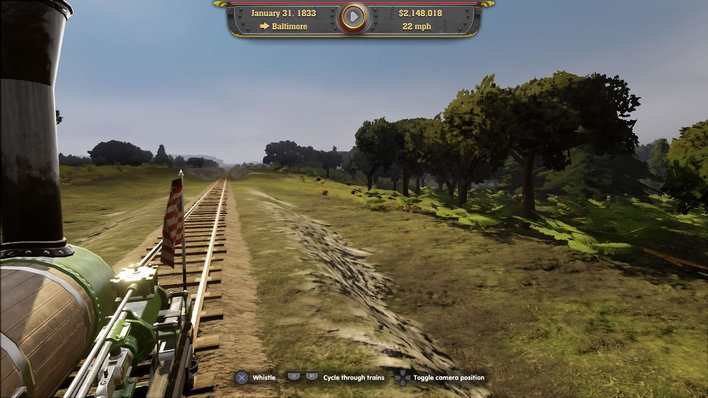
There's even a "ride along" option - and you can blow the whistle manually too!
However, Railway Empire is a game that's nothing if not scalable, with two very different difficulty settings that let you make the game either a punishing, quasi-realistic sim, or a lighter game that's more about balancing the books than planning your tracks.
On realistic - the game's "default" mode - each train behaves roughly as it would in real life. Only one train can be on the section of track at any one time, so you'll need to build regular passing points along the line, so trains don't end up smashing into each other head on, along with equally expansive stations to handle all the incoming traffic. While that all may sound straightforward enough, though, it very quickly turns into a massive headache - especially as you don't set timetables for your trains manually, or anything similar. Instead, regardless of whether they have anything to actually take with them, your trains will simply turn themselves around as quickly as possible, which very soon leads to some horrible bottlenecks near your cities - bottlenecks that are very hard to fix without deleting half of your railway and starting again. Needless to say, "realistic" is a hardcore mode for hardcore railway fans, as you're left to wrestle with points, signals, and passing places to try and ensure as smooth a journey for your trains as possible, even down to having to tell them what platform the service should run from and to, lest they all try and scramble for the same one, jamming themselves up entirely.
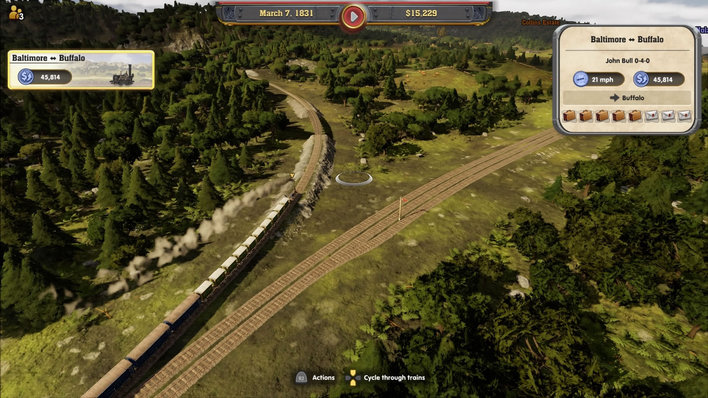
Even setting up one passing point is tricky enough...
On easy, on the other hand, things are a lot simpler. Rather than having to worry about getting your trains past each other, easy instead lets trains pass straight through each other, meaning a single line is often all you need to take several different types of train in different directions, to different places, all at the same time. They can even pull up on the same platform, "on top of" each other. Drastically minimising the amount of track you need, letting you instead focus on telling which trains to go where, easy really does make things a lot, lot easier.
The main meat of the game here comes from the "campaign" mode, which offers five different stages to complete, with each easily taking you several hours - and sometimes several attempts - to complete. Rather than just the one objective, each stage instead sets you a number of mandatory "tasks" to achieve, each with its own deadline you'll need to achieve it by. The first stage, for example, sees you setting up shop in Baltimore, Maryland, a city that apparently was best known for its clothes, which in turn are in high demand in New York. If you've ever played a game like this before, you can see where this is going. In order to ensure Baltimore's prosperity, it's up to you to ensure a steady stream of cotton makes its way from the local farm to Pittsburgh in order to be spun into fabric, and then make sure you have plenty of trains to haul the material on to the fabric thirsty city of Baltimore.
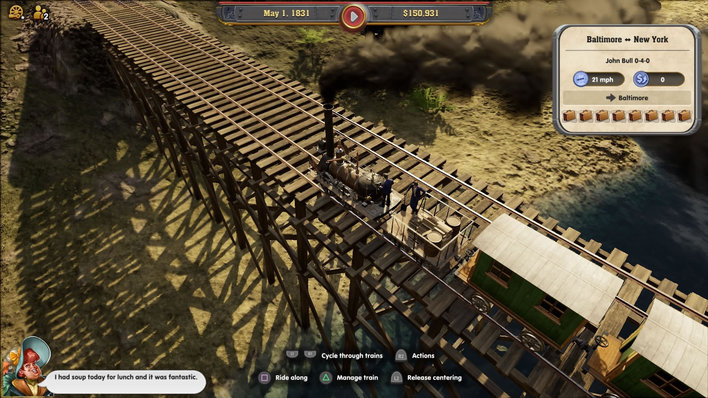
Some of the early train designs are great. Not sure we like the rickety bridge though.
Starting off in 1830, the game gives you around half a dozen tasks, from branching out to Pittsburgh by 1832, delivering 20 loads of clothing from Baltimore to New York by 1834, growing Baltimore to a population of 100,000 (basically by ensuring its business can grow, and people from other cities can get there) by 1838, and reaching a company value of $20 million by 1845, amongst others. And each of these goals is tricky enough to achieve on its own - yet alone when you have a couple of competitors breathing down your neck.
Yes, in Railway Empire you're rarely the only business magnate eager to lay down some rails, and each stage and scenario sees you coming up against a load of other tycoons who are eager to put you out of business. Not only can they lay down tracks in the very same cities as you (and thus steal your custom), but in the game's cutthroat world, they can even buy you out if they end up doing better than you. It's not uncommon to see notifications pop up from your foes mid-game, telling you they've bought 5% of your shares (even if, oddly, you don't actually see a penny from it). Should they get to 100%, you'll have a hostile takeover on your hands, and it'll be game over.
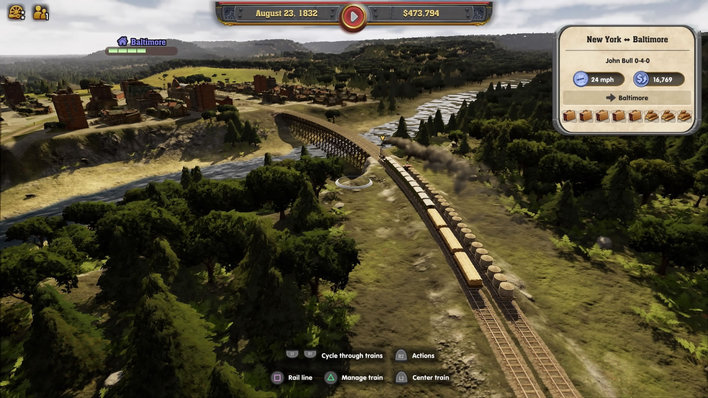
Your train's coaches/wagons will change depending on what they're transporting, which is a nice touch.
However, while that's totally fine in concept, in practice, how Railway Empire handles your competitors is one of the game's biggest drawbacks. If you're playing on realistic, and having to contend with a million different combinations of points and signals, it's fair to say you'll make somewhat slow progress. Not only will laying the railways cost more, as you'll need to lay more track, do more earthwork, and build more expensive and costly bridges and tunnels than your competitors, but your trains will be slower too, as you have an actual limit to how many trains can travel down one bit of track, and an absolute limit on platforms. Your computer controlled opponents, however, are always playing on easy. And that makes the game feel more than a little unfair to those willing to stretch out and try the harder mode.
Never is this feeling more obvious than when you've just spent the last half an hour perfecting your massive pre-station interchange, tweaking the complex mess of points, signals, and lay-bys to at least kind of free up the bottlenecks between your express passenger trains, and your slower goods trains that want to stop everywhere, only to see your opponent lay a single line into your town, and start running half a dozen trains down the same track in different directions, passing through each other with ease.
Should you just about manage to claw your way ahead of them enough to actually buy them out, too, what it means is you'll end up inheriting a load of railway that you can't actually do anything with. As your trains have a different set of rules to the AI's, you're left with a choice of either totally redesigning their track, or forgetting about it to concentrate on the bits you've already designed.

Not only that, but they even cut corners by laying their tracks in places you can't - like on the bottom of the chuffing sea!
And that's a real shame, as while the realistic mode is certainly more awkward, it also feels a lot more rewarding, essentially turning the game into one huge puzzle, engaging your brain in a way that few other games can. Yet while it may be fun while it lasts, doing your best, and gradually managing to get ahead, only to find the others kids have been looking at the answers the whole time kind of robs the game of a lot of its fun.
But that's not to say that playing on easy is boring, either - in fact, far from it. Railway Empire is one of those time sink games that you can happily pour hours into, or even spend the entire day playing, as you slowly peel back the layers of its many, many systems. The longer you play in each game, the more research points you'll unlock, in turn letting you unlock new, more powerful trains (all the way from 1830s steam up to 1910s diesel), technological innovations, new specialist types of coaches (like refrigerators for food produce) and everything in between. Outside of the game's "campaign", there's also a scenario mode, offering another set of 11 equally challenging stages, a sandbox mode, letting you customise your own rules, and a free mode, which gives you unlimited money, and no AI opponents, providing a more relaxing way of building the railway of your dreams, or simply start achievement/trophy hunting. In terms of in game strategies, we've found buying your competitors out as early as humanly possible seems to be a winning strategy so far - but as for the perfect combination of goods and passenger trains, or the most cost effective routes? We're still experimenting.
In all, then, Railway Empire is a real blast from the past, and the sort of game that simply doesn't get made anywhere near as much as it should do. While the tutorial leaves something to be desired, the localisation is sometimes a bit ropey (with a few too many examples on "Englisch" on show), and the interface could have used a bit of a going over (we're still not entirely sure how we can tell how much of each item a city's exporting), Railway Empire is a game that more than makes up for its slight lack of polish with a great atmosphere, a fantastic soundtrack, and gameplay that's rewarding enough, it'll keep coming back for more, whether you're a trainspotter/railfan or not. Now, if you'll excuse us, the 10:42 from New York to Baltimore's about to leave, and we've got to make sure they've remembered to load the flipping dresses this time.
Format Reviewed: Playstation 4




















